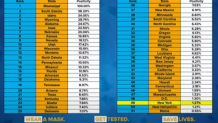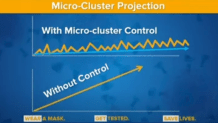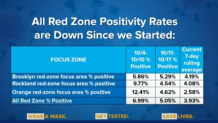What to Know
- Gov. Andrew Cuomo continues to tout the effectiveness of his micro-cluster strategy as "focus zone" areas see positivity rates dip; hospitalizations, which lag new cases, though have hit June highs
- NYC topped its 550 daily new case average threshold Monday for the second time in days, but schools remain a bright spot; just 0.51% of thousands of teacher and students tests have been positive
- New Jersey is having its struggles as well; Newark Mayor Ras Baraka is implementing new restrictions starting Tuesday in his city, including closing businesses at 8 p.m. and new health club mandates
New York City topped its 550 daily case average total for the second time in days Monday, while the mayor of New Jersey's largest city moved to implement new local restrictions as the Garden State's COVID numbers continue to soar.
Mayor Bill de Blasio said he wouldn't make any changes when asked about potential fallout from that daily case average number (551) topping his 550 threshold again. The other indicators show stable or even promising trends, he said, and urged people not to take any single number out of the larger context.
As of Monday, New York had the third-lowest infection rate in the nation (1.27 percent), behind only New Hampshire and Maine, according to data from Johns Hopkins. Seven states have a positivity rate above 20 percent.

Gov. Andrew Cuomo has championed the effectiveness of his micro-cluster strategy as "focus zone" areas continue to see positivity rates dip, though statewide hospitalizations, which tend to lag new cases, have hit June highs. New York, which is on the verge of a half-million confirmed COVID cases, is in the midst of a four-day stretch of hospitalizations above 1,000 for the first time in months, which isn't surprising given the recent increase in cases. Hospitalizations tend to lag new case increases; and death lags hospitalizations.
New Jersey has experienced significant upticks in its daily COVID case totals, hospitalizations and infection rate as of late. It reported its highest number of new daily cases (1,994) since early May over the weekend as Gov. Phil Murphy extended the public health emergency he put in place at the start of the pandemic for another 30 days.
The governor, who has been in voluntary isolation since learning of his exposure to a COVID positive staff member on Wednesday, still held his scheduled briefing virtually Monday after testing negative a number of times in the last few days. That's not the only reason; as Murphy said Monday, "the numbers are surging" and virtual briefings will be his dais for at least the next week, he said.
"We're in a tough spot right now. There's no other way to put it," Murphy said Monday. "We band together and do this as one team and get through this together."
Tracking Coronavirus in Tri-State
Thus far, Murphy has declined to implement new virus control measures to combat the recent spread in New Jersey, though he has said he is increasingly sobered by the numbers. He described the numbers as "sobering" once again Monday, reporting a ninth straight day with new cases topping 1,000 and a 1.23 transmission rate, noting it was the first time it went that high in a few weeks.
Why not impose new restrictions? According to Murphy, there has been no evidence that anything he can regulate -- like indoor dining or gyms, for example -- is causing the spread. He can't control what happens in people's private homes -- and he says those are increasingly becoming the sources of new cases.
"It is the act of individuals, particularly in private lives, in private homes, where we can crack the back of this," Murphy said.
Multiple counties saw more than 100 cases overnight yet again, though the governor acknowledged at least one bright point: Ocean and Monmouth counties, where New Jersey's recent upticks initially were traced, appear to have leveled off.
On the downside, the COVID increases have swallowed virtually the rest of the state, he has said. Hospitalizations hit 948 Monday, the highest total since early July. Essex County has been one of the state's highest viral growth areas in recent weeks. In Newark, the state's largest city, Mayor Ras Baraka took it upon himself to implement new control measures, saying his city is seeing more new cases than every other city in the county combined.
Based on testing information for Newark from Oct. 11 to Oct. 17, the city's positivity rate is 11.8 percent. It hasn't been that high since the end of May. In one ZIP code in particular (07105) on the east side, the positivity rate is more than 25 percent.
"Yesterday, Essex County had 161 new positive COVID cases, 101 of those cases were out of Newark alone," Baraka said. While the current levels are alarming, the mayor said they are not nearly to level they were at one point of the pandemic, when the positivity rate was around 68 percent.
Starting Tuesday, nonessential businesses must close by 8 p.m. nightly (supermarkets, pharmacies and gas stations are among the exceptions) and restaurants must end dine-in at the same time. Beauty and nail salons, along with barbershops, must be appointment-only. Gyms and health clubs are required to close for half an hour each hour for sanitizing, cutting the amount of service time in half.
Baraka said that the measures are done in effort to prevent large gatherings around the city, and to tackle what he believes are people lowering their guard as a result of COVID fatigue.
Murphy said the state would ramp up testing in key hotspot areas of the city and assist with contact tracing and enforcement efforts. The governor said he had spoken with Baraka and stood beside him amid the latest viral uptick in Newark.
"They have painful history with what happens when this thing flares up," Murphy says. "No community has seen that pain more than Newark and we are right beside in the steps he’s taken and the ones we're taking with him."
Mayor Baraka said the city will reassess the situation after November 10 to decide on the next steps necessary.
Daily Percentage of Positive Tests by New York Region
Gov. Andrew Cuomo breaks the state into 10 regions for testing purposes and tracks positivity rates to identify potential hotspots. Here's the latest tracking data by region and for the five boroughs. For the latest county-level results statewide, click here
Source: ny.gov
NY Blasts WH Chief of Staff for Saying Pandemic Can't Be Controlled
The latest upticks aren't a New Jersey problem or a New York one. They come as COVID continues its latest surge across America. The United States broke its daily new case record on Thursday. Then it set another new record on Friday.
And deaths per day are on the rise once again.
Amid these developments, the president's chief of staff stewed new controversy Sunday when he told CNN that the federal government cannot control the pandemic and should instead focus on vaccines and treatment solutions.
Both Cuomo and de Blasio vociferously condemned Mark Meadows' comments, accusing him of surrendering to the pandemic and flouting virus control strategies that New York has proven can work.
"We have been controlling the pandemic right here in New York City," de Blasio said. "We have been proving that if you engage the people and you provide the masks and the testing and the support you can stop this pandemic from growing."

Despite recent upticks, New York maintains one of the lowest transmission rates in the country -- a remarkable turnaround for the former epicenter of the national crisis. Its "hotspot" infection rates, while high by New York's current standards, are up to 10 times lower than the regular state of play in some states. Data shows all red zone positivity rates are down since the program started, Cuomo said.
As of Monday, the average positivity rate in the realigned red zones is 3.25 percent, up slightly from Sunday, while the rate outside those areas is just above 1 percent. Students who abruptly switched all-remote at more than 100 New York City public schools in neighborhoods where positivity rates soared a month ago returned in person Monday, following Cuomo's move to ease some restrictions.

Schools have been a bright spot in New York City's war against coronavirus overall, de Blasio says. Of thousands of randomized tests conducted on students and staff in New York City over the last few weeks, part of which was required under Cuomo's cluster plan, just 0.15 percent have tested positive.
So far, more than 280,000 NYC public school students have attended class in person, according to the city's Department of Education. That's a far higher number than many other major U.S. school districts, the largest of which have stayed remote except for New York, but it only reflects about a quarter of the total student population in the city. Daily attendance remains around 85 percent, for both in-person and remote learning.
In-person attendance has averaged about 83 percent, while remote attendance is a bit higher (85.5 percent). De Blasio says he's working to get in-person attendance up -- and reminded parents who initially opted out of blended learning that they have an opportunity to opt back in Nov. 2 through Nov. 15. The NYC schools chancellor said it will be the only chance to opt back for in-person learning for the rest of 2020.
"We are lower than we anticipated with in-person learners and know families initially had hesitations," said Chancellor Richard Carranzza. "No replacement for in-person learning, it is safe to do so."
Parents can find details on COVID cases in schools here and check the city's COVID case map for details.
Cuomo has said he would reassess the cluster zone maps on a rolling 10-day basis, meaning some areas that saw restrictions extended early last week could be poised to have them lifted by the end of this one. And more kids may get back to class sooner rather than later, albeit still shrouded in the shadow of COVID.
The governor has said, along with many others, that life in the U.S. won't return to any semblance of normalcy until there is a widely available and effective vaccine. He has established a task force to first independently assess the safety of any that receive emergency use authorization from the FDA.
Then he faces the herculean job of delivering and administering it to up to 40 million people, many of whom may distrust it initially. Mayor de Blasio has said he is working with the state on a strategy to deliver a vaccine within the five boroughs when it becomes available.
Murphy detailed his plans for an equitable vaccine rollout in New Jersey on Monday afternoon. In alignment with Cuomo's concerns, he warned, "Skepticism of the vaccine could prove to be as deadly than COVID-19 itself."



